Breathing new life into older content is critical for success.
Upkeep and content of your older pieces can bring dramatic improvements to top rankings in Google and increase overall organic CTR.
As search engines and reader preferences evolve, maintaining up-to-date information becomes crucial for keeping your audience engaged.
AI tools can help you identify which articles need refreshing and suggest enhancements that align with current SEO practices.
Combine these AI-generated recommendations with human creativity, and you will have fresh and accurate content that retains your brand’s unique voice.
This article will guide you through using generative AI effectively to update old content, helping you maintain relevance in an ever-changing online environment.
How to update old content: A step-by-step process
Stagnant content is a recipe for declining engagement and lost relevance. Artificial Intelligence – specifically generative AI – has emerged as a key tool in breathing new life into old content, ensuring it continues to captivate audiences and meet the ever-changing standards of search engines.
So, how do you evaluate which content needs an update?
Don’t just guess or use intuition – dig into the data. Metrics such as organic traffic decline or lower engagement rates can be telling signs that your content may require refreshing.
To pinpoint these key indicators, Google Analytics provides comprehensive tools to assess user behavior and page performance.
First, open your desired report in GA4 and look into your landing pages.
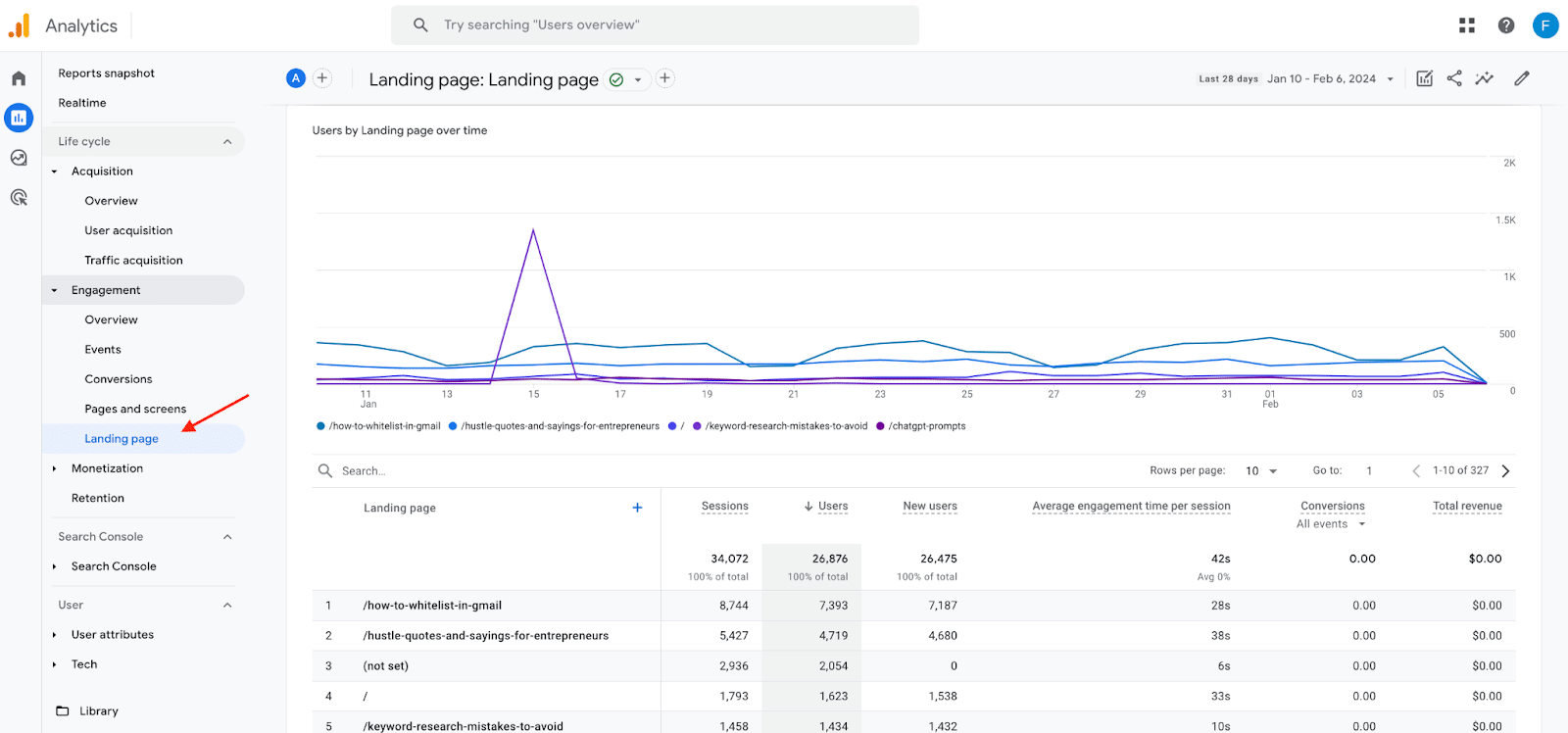
Then, customize the report by adding a time comparison to analyze which pages lost traffic during a particular time period.
For example, compare the last 3 months vs. the previous period.
To do this, click on the date in the upper right corner, choose the date, and click the Apply button.
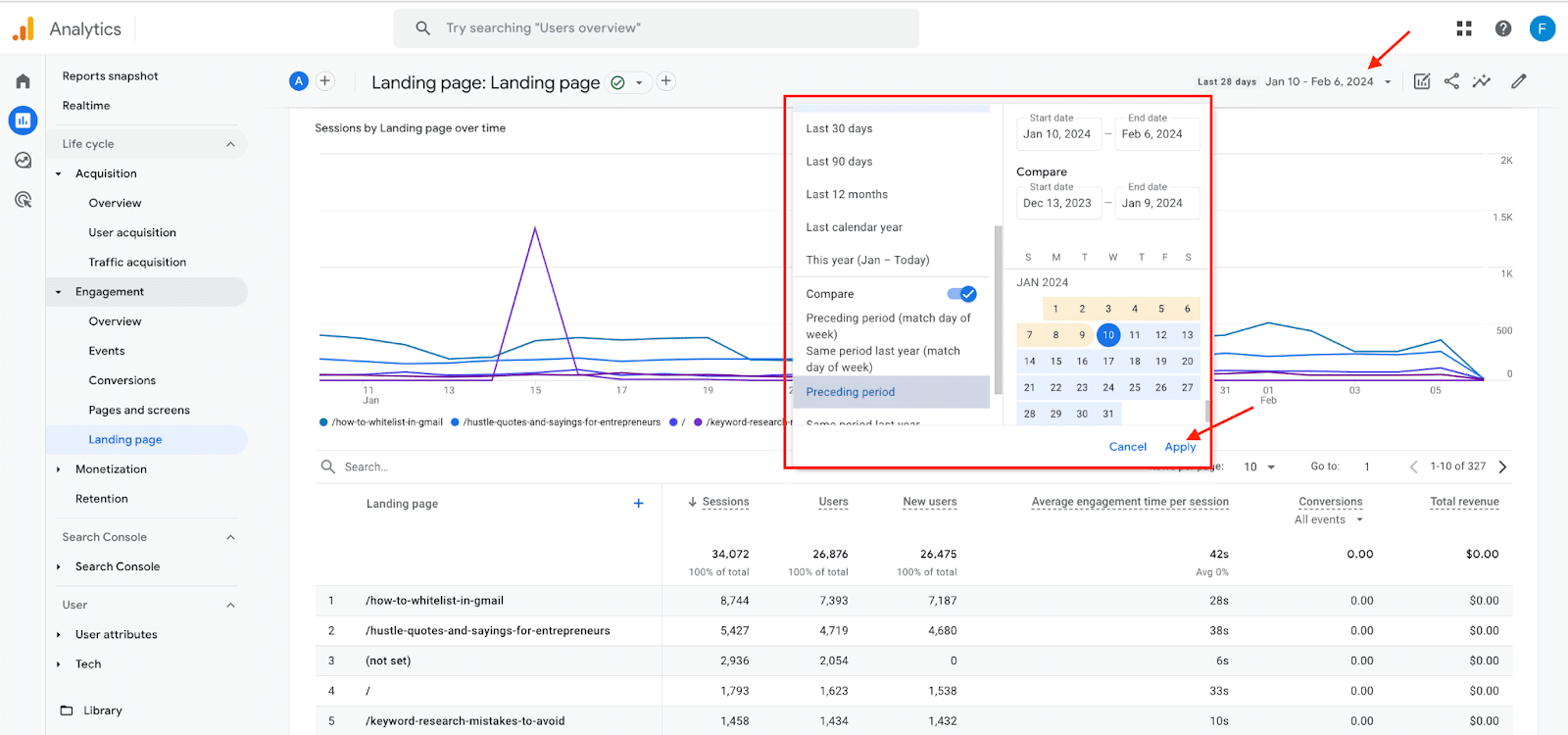
Look into each metric, specifically the “%change” row. You can sort the data from up to down and vice versa by clicking the arrow beside each metric.
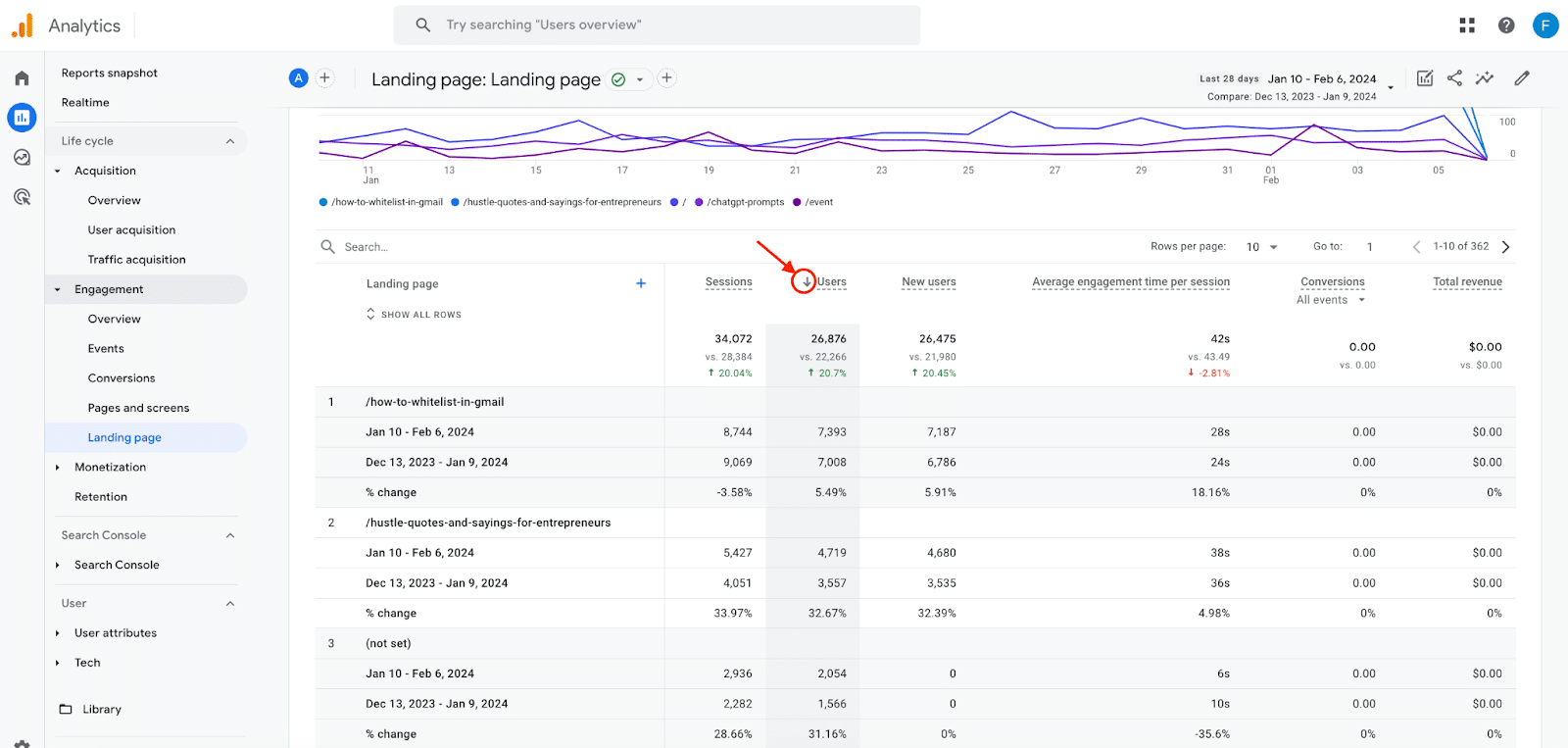
Now look at the negative changes and analyze further for traffic fall. You should also check the growing ones – these are great for updating or refreshing.
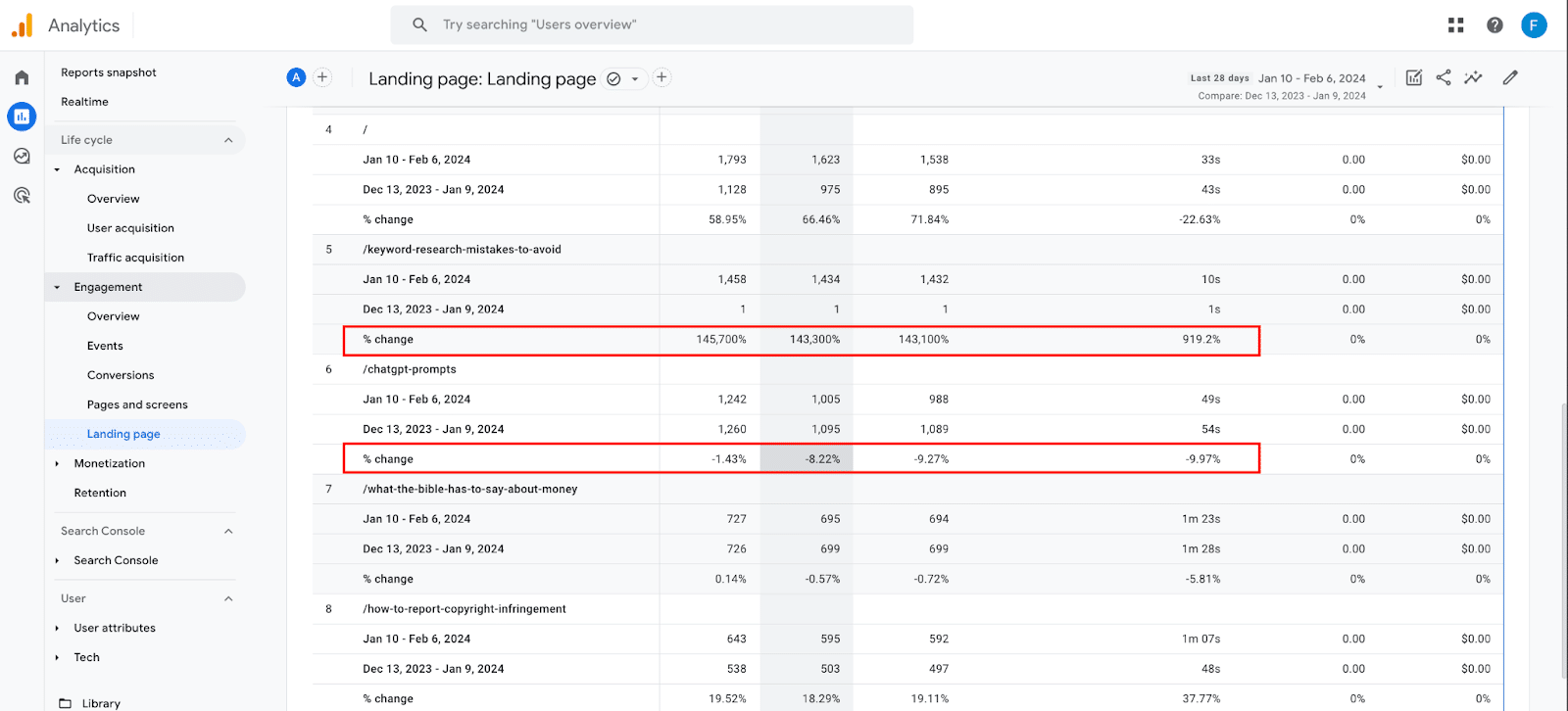
Another way to find old content that’s due for an update is to check their publication dates against current industry trends.
This process will help you decide which pieces are dated and could benefit from a rewrite or refresh. For instance, articles with outdated statistics or references to discontinued products clearly need an update.
First, open WordPress or any other CMS you are using.
Click All Posts and sort by date from oldest to newest.
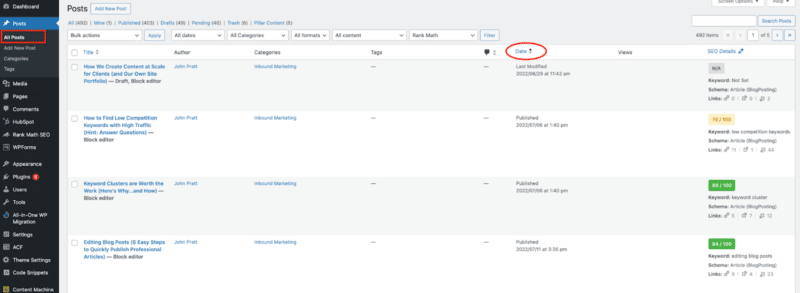
Look into your old posts and check if they have outdated information that needs to be changed or removed.
When evaluating content, focus on pages that historically performed well but have seen recent dips in traction. These are likely to regain their stature after a refresh.
How to use generative AI for content enhancement
Now that you have a list of pages that need updating, it’s time to let AI work its magic.
Generative AI tools like ChatGPT can help you rewrite sections of old posts to bring them back to relevance while ensuring they meet current SEO standards.
Start by feeding your old content into the AI tool. It will review what you have, looking at engagement metrics and current relevance.
Sample prompt for content analysis:
- “Analyze the user engagement metrics of our article titled ‘The Future of Renewable Energy’ and provide suggestions on sections that may require updates or additional information.”
Generative AI can also help spot areas where the information might be outdated or lacking depth. This could mean anything from stats that need updating to sections that require more detailed explanations.
Sample prompt for identifying gaps:
- “Review our blog post ‘Top SEO Strategies for 2020’ and identify any topics that have become outdated or new industry practices that should be included in an updated version.”
When you feed these tools specific prompts about your topic, they generate new content that can blend seamlessly with your existing material.
To leverage these tools effectively, give them detailed instructions. Outline what you want the updated section to achieve in terms of tone, style, and information coverage. This way, you get targeted results that align closely with your original intent yet bring new life to older content.
Not sure which sections you need to rewrite or update?
Here’s a neat trick: run a full content optimization audit.
A content optimization audit dives deep into your existing material and identifies areas for improvement – essentially, what’s working well for your audience and what isn’t.
The tool will scan your content and look at things like readability, mobile-friendliness, how engaging your content is, and if people are finding you – and not your competitor – when they do a Google search.
After digging into all this stuff, AI will suggest tweaks to improve the performance of your content. These recommendations ensure that when someone lands on your page, they find exactly what they’re looking for and ultimately take action.
Updating content with ChatGPT
You can manually implement the recommendations from your audit report, or you can ask AI to do it. Generative AI tools like ChatGPT are perfect for these tasks.
Here are some ways ChatGPT can help refresh your old content and sample prompts for each item.
Research assistance
Generative AI tools are pretty handy when it comes to researching current trends, statistics, and data relevant to your topic. They can provide you with new material that can make your content feel updated and fresh.
Sample prompt:
- “Conduct research on the latest developments in remote work technology since 2021, and compile relevant data and statistics to update our existing guide on remote collaboration tools.”
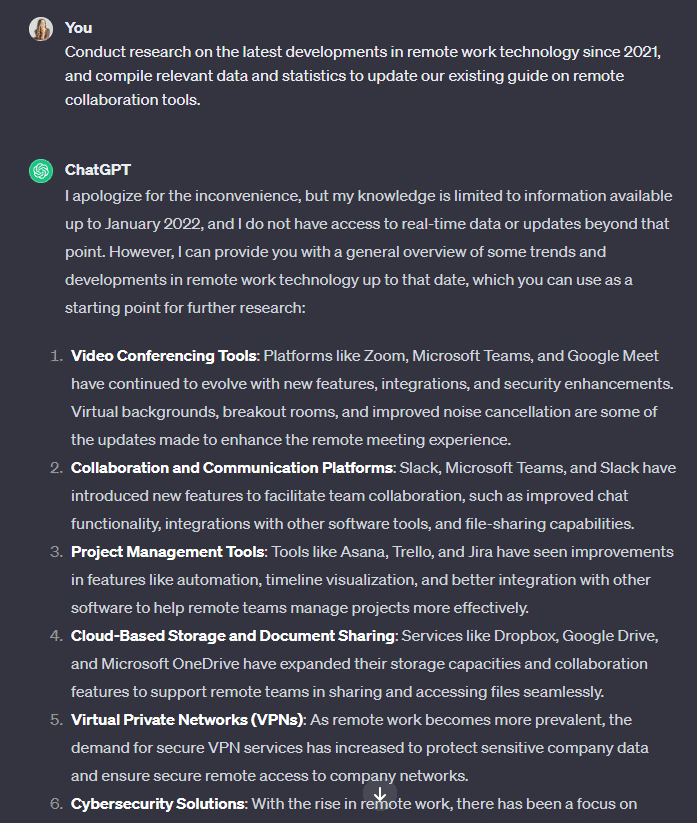
Rewrite content
With all this new info in hand, the AI can assist in rephrasing paragraphs or suggesting entirely new sections that reflect recent developments in the field related to your content piece.
Sample prompt:
- “Rewrite the introduction paragraph of our case study ‘Boosting E-commerce Sales Through Social Media Marketing’ to reflect recent social media algorithm changes affecting marketing strategies.”
Add multimedia elements
Adding images, infographics, and videos is a great way to give your old content a more engaging, modern feel. The idea is to make your articles more interactive and visually appealing using generative AI image/video generators.
Sample prompt:
- “Create an image around the concept of ‘urban gardening in small spaces’. The illustration should depict a bright and airy balcony in a high-rise apartment building, filled with potted plants such as tomatoes, herbs, and flowers. Include a person tending to the plants comfortably seated on an eco-friendly bamboo chair. Aim for an optimistic atmosphere with morning sunlight filtering through.”
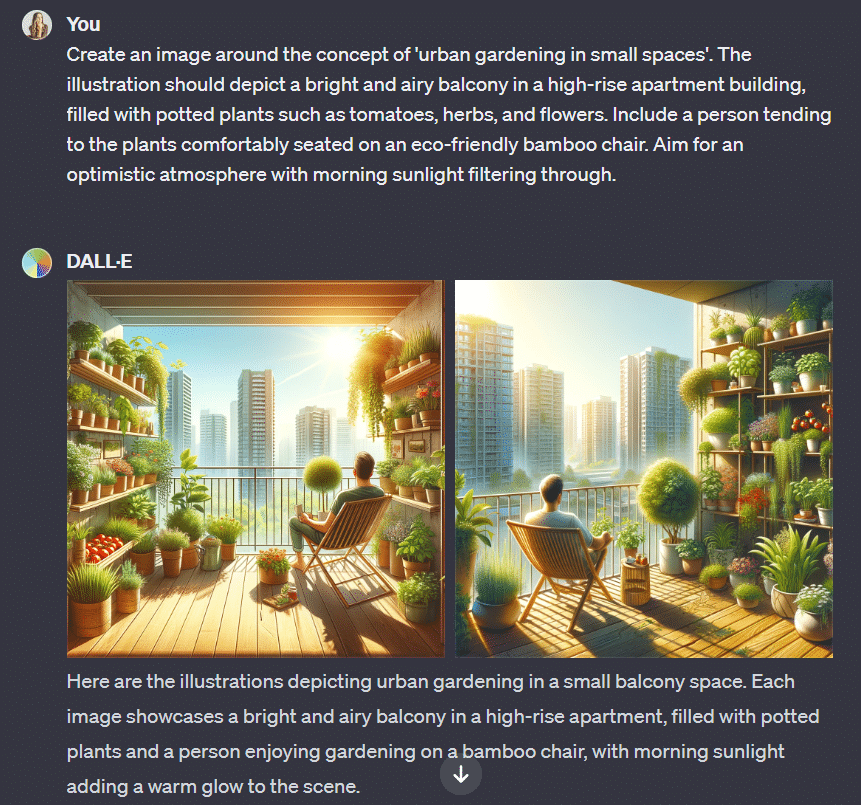
Optimize for search
By analyzing search trends and keyword performance, an AI tool can suggest tweaks in word choice or topics covered so that search engines find – and love – your newly polished article just as much as readers will.
Sample prompt:
- “Examine keyword performance for my cooking blog’s post ‘10 Healthy Dinner Recipes’ from last year, suggest more current trending keywords related to healthy eating, and optimize it accordingly.”
Readability check
A big part of keeping visitors on-page is making sure they don’t get lost in jargon-heavy text walls. Here, generative AIs offer readability checks to ensure language isn’t only up-to-date but also accessible.
Sample prompt:
- “Evaluate the readability score of our technical whitepaper ‘Understanding Blockchain Technology’, simplify complex terminologies without changing the meaning.”
Generative AI makes improving/updating existing content far less daunting and allows creative human input to blend seamlessly with cutting-edge technology. With the right prompts, you can turn ChatGPT into your virtual assistant for revitalizing old content.
Dig deeper: Advanced AI prompt engineering strategies for SEO
Integrating AI suggestions with human creativity
With generative AI tools at your disposal, the time-consuming task of refreshing old content becomes far more efficient. But to effectively implement these AI-generated suggestions, you need the help of a human editor.
Here are five reasons why:
- Contextual understanding: AI might be brilliant at crunching data and spotting patterns, but it doesn’t truly understand context or cultural nuances like humans. A person can discern whether an update or change aligns with current events or societal shifts that may not yet be reflected in available data.
- Brand voice consistency: A human editor understands brand voice and will make sure any changes to your content don’t stray from your brand’s personality.
- Editorial judgment: While AI can suggest many potential improvements based on trends and metrics, it’s up to humans to make editorial decisions about what’s most relevant and valuable for their specific audience – prioritizing authenticity over algorithmic predictions.
- Creativity and originality: Humans bring creative flair – a critical ingredient if you want your content to stand out rather than sound generic. Only humans who speak the native language can detect subtleties such as idioms, humor, or local colloquialisms that resonate with readers.
- Ethical considerations: It takes human oversight to ensure generative AI recommendations do not inadvertently perpetuate biases, especially for sensitive topics where a moral compass supersedes programmed codes.
Revamping old content just got easier
Alright, let’s tie this all together. We’ve seen how generative AI can be an effective tool for sprucing up old content. It’s like having that super-smart buddy who gives you all the stats and facts you need to make your stuff shine.
But as we’ve seen, it’s not just about letting AI do its thing; it’s about us jumping in there, too – getting our hands dirty by adding those personal touches that only humans can. Because at the end of the day, it’s about striking that sweet spot where tech meets human intuition.
So next time you give your older articles a makeover with the help of an AI tool, sprinkle in your insights and keep things relatable because people connect with people – not robots.
By combining AI’s production speed and human creativity, you’re setting yourself up for content that doesn’t just tick boxes for search engines but also hits home with every person reading it.
Dig deeper: Improving or removing content for SEO: How to do it the right way
